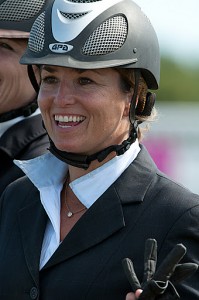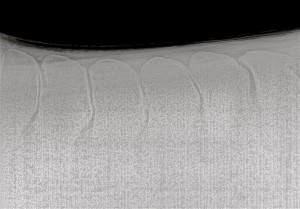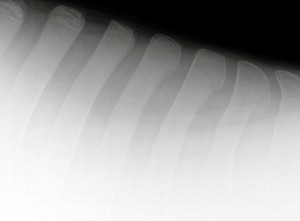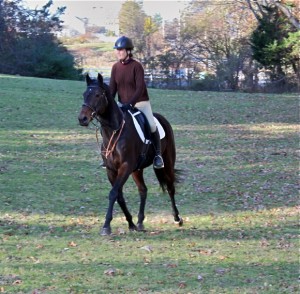Dr. Liz Maloney, DVM, owner of Equine Therapies in Franklin, Mass., has practiced veterinary medicine with a special interest in horse performance issues for 19 years. Her career started at the racetrack, before expanding to include the care and treatment of sport horses in most other disciplines.
An active competitor in the amateur-owner jumper division in Wellington and Canada, Dr. Maloney took time out of her very busy schedule to answer questions about an equine back condition commonly referred to as kissing spine. In a Q&A with Off-TrackThoroughbreds.com, Dr. Maloney offers insights on the condition and its treatment.
Q: In laymen’s terms, can you please define ‘kissing spine,’ and also provide the medical name as well?
A: Kissing spine, which in technical terms is referred to as the impingement of the dorsal spinous processes, is a diagnosis made through evaluating radiographs of a horse’s back. The condition occurs in the dorsal spinous processes, which is the tips of the spine that you can feel if you press down on the horse’s midline. When they touch or overlap this is considered to be “kissing.”
Although kissing spine is suspected to occur in 39% of the horse population, it is not always a source of pain. Kissing spines are more likely to be clinically significant in Thoroughbreds and dressage horses, in horses under 5-years-old and when more than five vertebra are kissing.
Q: What are the symptoms of kissing spine?
The symptoms of kissing spine can be variable and are often misread by riders as behavioral issues. An obvious symptom is when the saddle is brought out the horse may show anxiety on the crossties (shifting his weight and moving his bowels often). Then when the saddle is placed on his back he lowers his back under its light pressure. Or, when he is girthed he bites at the air or the crossties.
Other behavioral clues continue as he is led away from the crossties. He may walk very slowly and sometimes like a crab. And once at the mounting block, he may position himself in such a way that the rider has difficulty mounting.
Signs continue once the rider mounts. This is when he may drop his back and “scoot” forward. Under saddle he may be particularly anxious and appear to be ready to explode.
In general, these horses are uncomfortable with weight on their backs and don’t want to be ridden. So they will often make lots of excuses not to work such as spooking, bucking, bolting, refusing jumps or bolting towards and away from jumps, kicking out and shaking their heads. Under saddle, they may be very stiff in one direction, hollow, hard to put on the bit or reluctant to make transitions. Of course some of these symptoms could be attributed to other problems and not all of these symptoms need to be present to consider back pain as a diagnosis.
Q: Once a horse is suspected to have kissing spine, how is it diagnosed?
A: There are horses who have back pain without kissing spine, and there are horses who show kissing spine on X-rays but do not have back pain. Therefore it is important when this diagnosis is made on X-rays, that the symptoms and regions of the back that palpate painfully correlate with the same regions on the back that look abnormal on the X-ray. Radiographs are only one piece of the puzzle when determining if a horse has back pain, so simply radiographing a prospective horse’s back to see if he has back problems is not sufficient.
Q: What are some of the factors contributing to this condition?
A: At this point we consider that a horse may be genetically predisposed to this diagnosis. For example, the horse may have a very short back or prominent withers with a low back. And the condition can also be exacerbated by riding exercises. Any factors that may make the horse drop his back and invert can contribute to worsening of the problem; including issues such as poor saddle fit, weakness, poor riding, gastric ulcers or front or back leg lameness.
For example, if a horse’s front feet hurt because he is barefoot and has thin soles he will carry his head high and drop his back. Then, if he is young and weak and his rider is heavy and inexperienced sitting in a saddle that does not fit, well then he will invert even further.
Q: Once the diagnosis is made, what are the treatment options?
The treatment is two-fold: First, stop the pain; and second, strengthen the back and abdominal muscles.
There are a variety of ways to control the pain: cortisone injections, shockwave therapy, mesotherapy, chiropractic, acupuncture, non-steroidal anti-inflammatory medications, and muscle relaxants. Every case is different and some horses will respond better to one therapy than another.
There is a lot of new information out there about physical therapy and strengthening exercises to build up a horse’s back. Most start without a rider on the back and involve a long and low frame and gradual re-introduction of a rider.
Q: What is the cost of some of these treatment options?
Some of the treatments, such as shockwave therapy, can be quite costly (up to $400 a treatment). Most treatments are not this pricey. If you think your horse has kissing spine be sure to hire professionals who have experience identifying and managing this problem. In some cases a bone scan may be needed to localize the most painful areas of the back, in addition to ultrasound, thermography and radiography.
Q: In general, can a horse diagnosed with this condition have a future as a riding mount?
Most horses with kissing spine can be rehabilitated and returned to function. There are a lot of show horses out there competing, who have the problem managed by their trainers and veterinarians. Once the problem is identified and treated it is important for the owners to be aware if the horse’s symptoms are recurring.
Correct saddle fit is important. Gone are the days when a rider’s saddle can be expected to fit the six different horses she has in training! And, as a horse builds muscle and changes shape to adjust to his new career, the saddle may need to be adjusted.
Q: Can you speak specifically about ex-racehorses you have treated for this condition?
In my practice, I see retired racehorses that have a diagnosis of kissing spine that can happily go on to other careers with proper management.
It’s important for owners to know that most ill behaviors that horses manifest are because they are in pain. In my experience there are few horses that buck, rear or bolt just to be bad! They are a prey species and don’t want to stand out in the herd as troublemakers. After 19 years of practice I am still amazed at how many “hot” horses actually become relaxed and “lazy” once their pain is addressed.
Q: How will a horse let you know if his or her back is hurting?
I find pain in the back of the horse to be one of the few reasons that a horse will say “no” when asked to perform. With hock pain or fetlock pain for example they may limp but they will still do what we ask. But when it comes to their backs they may show explosive reactions, almost as if they have received an electric shock, making them buck, bolt or rear.
Q: Back pain seems to be something that is better understood today by vets. Can you speak about that?
The good news is that we are getting better at identifying back pain and prescribing a treatment plan as most veterinarians are more aware of it. I think back pain is no more common now, than it was when we started putting weight on a horse’s backs ,but we are now recognizing it much earlier as a cause of poor performance.
Q: Any additional thoughts?
A: I continue to be amazed at how horses work for us even when their bodies hurt, and I strive to become a better veterinarian to identify and ease their pain.






Hi, I’m currently doing an essay at university on kissing spine and we have to discuss a topic so I chose kissing spine, and I have to get arguments for and against if racing alone causes kissing spine more than other disciplines, just wondered if anyone knows any papers on this or if you yourself have a idea on this.
hello every one, my daughters OTTB 9 year old started having problems right after fall shots every one assumed he was a reaction to the shots nothing major just giving her a hard time when she rode.after 3 weeks she realize some thing wrong called the vet out to day kissing spine vet gave him a shot said he should be fine may need a shot yearly may not time will tell.thank you for this article I never heard of kissing spine till today feel a lot better about it now that i know a little about it but would still like to know how or why a 9 year come down with it .before his shots he was perfect????
Mine was also 9 when he presented symptoms out of the blue, we were at a dressage clinic working on taking the bit and trying a little frame (since he’s pretty inexperienced and has only been ridden for about a year and 1/2 at this point). We had been getting the hang of it, but then at this clinic he refused to accept the bit, and he started switching his lead behind when going left, but only picked up the left lead when going right. Before then he took up bucking or throwing himself around while shaking his Head. His sister has a worse case than him, so we figured it’s kissing spine. He’s a TB X Percheron
I’d love more information on this diagnosis. Mainly regarding future career possibilities.
My Connemara X pony has kissing spine syndrome. He has a short back and is slightly swayed. He has two inflammed areas of muscle either side of his dorsal lumbar area.
He has has chiropractic treatments and many massages. Neither have helped at all.
My next step will be cortisone injections I imagine. I am also using Hyglide by Hi Gain which increases joint fluid. I have been instructed to excercise him with a Pessoa lunging system over trotting poles and cavalettis. The aim is to have him build stomach muscles and create a more collected form to counteract the swayed back which will help put more of a space between each vertabrate.
So far he has resisted collecting on the Pessoa. We have been lunging daily for 18 mins for almost a month. I am also working him laterally, side passing him on the ground. No ridden work of course. Also having him bend his neck both ways to soften him which he does very well. I really need to have success getting him to collect though.
Niki, the pessoa isn’t the best tool, in my opinion. I may influence the horse for a brief while to track up and under more, but after the horse gets used to it, it doesn’t work as well as simply learning how to lunge well. You can try Art2Ride.com to find out how to teach a horse how to stretch toward the bit and work over his back. You shouldn’t be so concerned about collecting for at least a year. That’s how long rehabbing a horse with kissing spines takes.
My horse has been diagnosed with Severe Kissing Spines. Read his success story on GTtrainingvt.com and click on Williams page. Compliments to Peggy Murray, Gentle touch training. Visit her facebook page at Gentle touch training and see more photos of William.
I am wondering if a horse lowering its head to the ground a lot while being lunged or ridden or leaning way back on its haunches as it stretches out the front legs would be considered other symptoms that is manifested by the kissing spine?
Thank you for writing this article on Kissing Spine. My friend recently suggested Kissing Spine as the reason for my OTTB’s ‘behavior’. I had never heard of it and have started researching information on it. The symptom description describes my horse to a T. He also lowers his head to the ground when being ridden on a loose rein. In fact, especially with his build, people thought he was a Quarter Horse instead of a Thoroughbred. Every fall when we change our clocks back he becomes downright nasty and grumpy and stays that way until spring when we move the clocks ahead. I think the cold weather here in Ohio must make him hurt more. Does anyone else have that problem with their horse?
I know these are old posts, but have only just been sent the link to this.
Kathy, thank god! My TBx is exactly the same. She is so miserable, grumpy & generally hard work during the winter, am sure she suffers from SAD. Yet as you say as soon as spring weather appears, she becomes a different horse.
Mine has just been diagnosed with Kissing Spine, something our physio didn’t pick up on & kept saying it was the saddle. Got an Osteo in & she diagnosed it straight away with all the above signs plus discomfort on one rein, growling at me when placing saddle & doing girth up, and started to refuse at jumping. It has already cost me a fortune but am hoping that with lungeing and rest, her condition will improve, at least enough for her to become a brood mare.
Jane,
You’re right that this is an older post, but people keep looking at it. I should do another story. Anyway, if you see this, I sent you a PM. Best, Sue
Lynn – did you find out whether lowering the head (to the point where the nose is occasionally touching the floor) is associated with Kissing Spine? I’m worries that a horse that I train may have Kissing Spine. When he is lunged in walk and trot he often does this and almost looks like the type of movement where he is about to get down and roll (thankfully he hasn’t rolled and I push him on as I don’t want him to roll in my saddle).
My 6 year old ex-racer is currently stabled at the vets and will be having xrays tomorrow to confirm a possible kissing spine, or bone spavin, although she is young for this 🙁 which could be causing the back pain as a transferred secondary issue. I would like to say thank you, this article has made me feel a whole lot more positive about her diagnosis 🙂 This explains a lot of issues clearly in “lay-mans terms” and for that I am grateful.
Nicola,
I’m glad the article gave you some hope. I think there’s a link to Dr. Maloney’s practice, if you need a second opinion. She’s very approachable.
Thanks for this article. Had never heard of Kissing Spine. But it explains a lot of thing… Nice to hear from a vet who is in the business FOR the horses and not BECAUSE of them.
Great to have her in our corner!